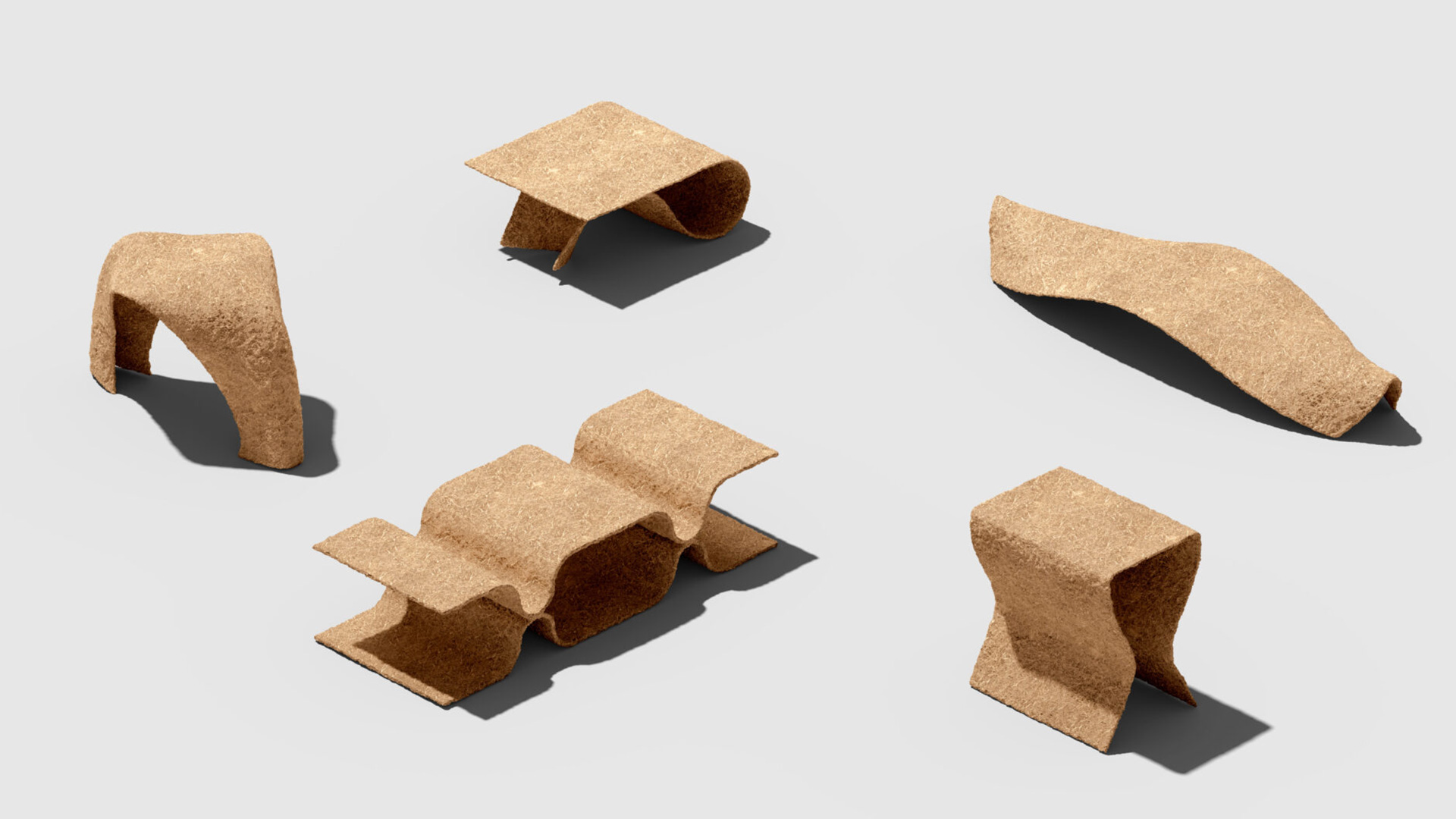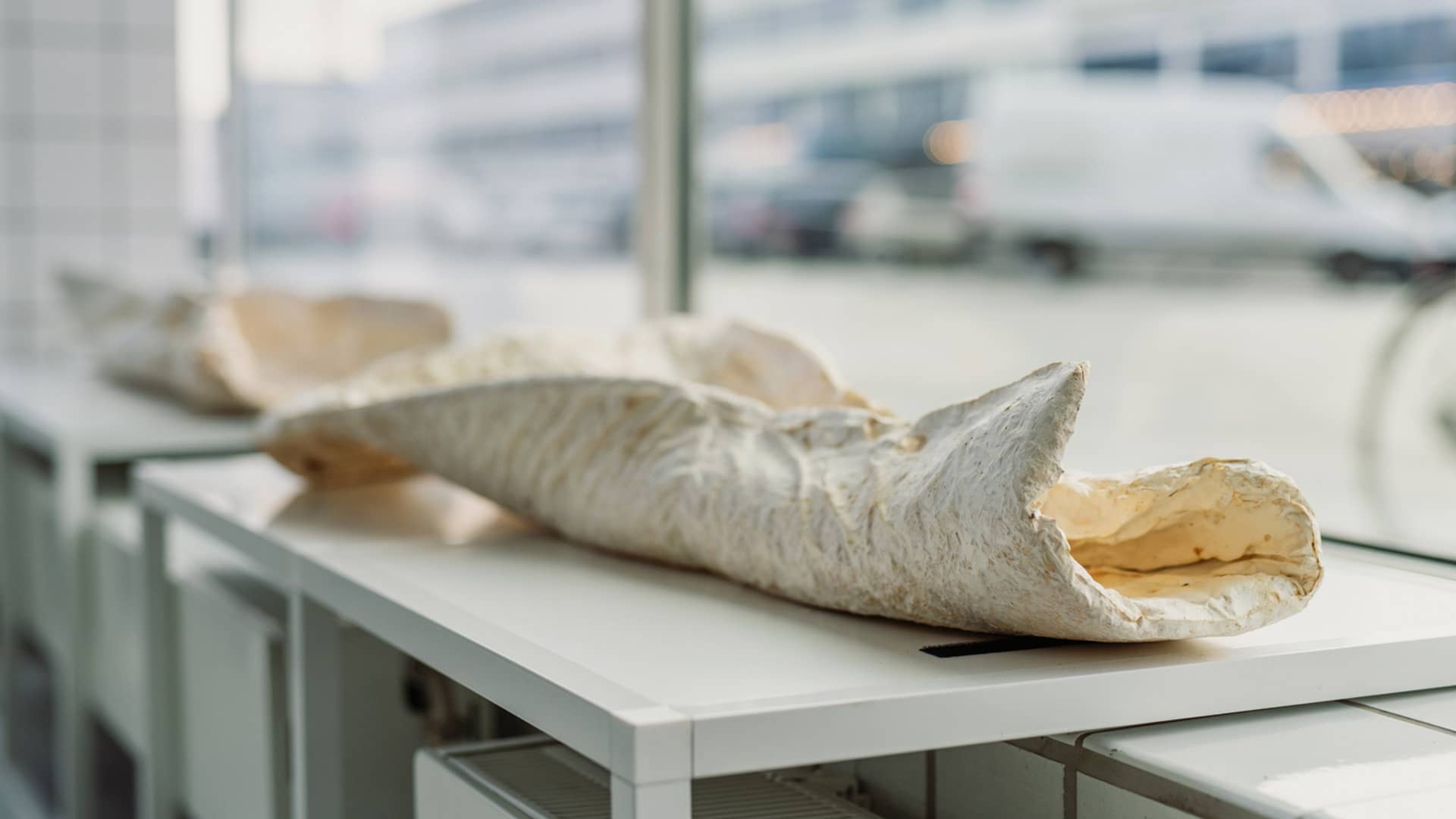Bio-Fold: FRAKTA Bag
From laundry and storage to gardening and transportation, few IKEA products have as many creative uses as the FRAKTA shopping bag. Therefore it was the perfect place to start experimenting with circular fabrication methods using everyday tools, biodegradable materials, and a touch of imagination.
Rethinking FRAKTA
How do we democratise the benefits of parametric design? How can we develop more sustainable furniture fabrication, using already existing everyday objects? Is it possible to grow and cast furniture from home? These were some of the questions that architects Katya Bryskina and Tomás Clavijo set out to explore during their residency at SPACE10, as part of our collaboration with Strelka Institute. With a shared passion for sustainability, Katya and Tomás combined their expertise in parametric design and innovation strategy to imagine a new circular fabrication model. Specifically, they wanted to explore how the IKEA FRAKTA shopping bag might be used as a tool to grow, cast, and shape furniture using locally sourced biodegradable materials.
From waste to material
Agricultural production disposes of great amounts of waste, in the form of vegetal fibres. On a global scale, these natural by-products show significant promise for the production of biodegradable composite materials, or simply biocomposites. Biocomposites are formed by mixing vegetal fibres with a natural binder — such as plant-based resin or bicarbonates — and compressing the material into a solid form. As a material, they are renewable, cheap, biodegradable and in many cases completely recyclable. When communities are empowered with the right methods and tools, vegetal fibres can turn from ‘waste’ into ‘material’ – and become a cheap and locally sourced material for the production of everyday objects. Katya and Tomás experimented with biodegradable binders and vegetal fibres to create materials that can be used for fabricating furniture. However, the perfect recipe for biocomposite furniture production is yet to be discovered. A good way to get to know biocomposites is to explore open-source materials’ libraries, such as Materiom, which provide ‘recipes’ from natural and easily available materials.
Design by FRAKTA
Using simple household tools and the ubiquitous Frakta bag means that this process could be used by anyone, anywhere, to create circular furniture from their own home. This opens up the opportunity to encourage truly democratic expansion of circular design. How could we scale up this process to create systemic change? With this question in mind, Tomás and Katya developed a concept and a folding logic for a parametric design platform. Using this folding logic, they designed five furniture prototypes, including a chair, a shelving system, two tables, and a stool — each based on the dimensions of the reconstructed Frakta shopping bag. Bio-Fold is not a recipe for transforming linear production into circular. Rather, we wish to highlight the opportunity for how everyday objects and materials — with a bit of imagination — can enable sustainable fabrication, use, and recycling of products. Ultimately, we wish to invite others to challenge conventional uses for everyday objects, and inspire them to design for themselves. Only then can we truly explore the possibilities of decentralised fabrication, and spark a global transition to circular systems.
Credits
Katya Bryskina is an architect, artist, and computational designer. She combines digital fabrication and inspiration from biology to bring ecosystemic thought and aesthetics to the built environment.
Tomás Clavijo is an architect and innovation strategist, operating globally through the platform RAFT, where he combines hard facts and cultural strategies to create speculative models for the present.
Barkas is an independent brand studio, working with companies and people to design their strategy, brand, product and service. They challenge business as usual to bring clarity to an increasingly complex world.
From laundry and storage to gardening and transportation, few IKEA products have as many creative uses as the FRAKTA shopping bag. Therefore it was the perfect place to start experimenting with circular fabrication methods using everyday tools, biodegradable materials, and a touch of imagination.
Rethinking FRAKTA
How do we democratise the benefits of parametric design? How can we develop more sustainable furniture fabrication, using already existing everyday objects? Is it possible to grow and cast furniture from home? These were some of the questions that architects Katya Bryskina and Tomás Clavijo set out to explore during their residency at SPACE10, as part of our collaboration with Strelka Institute. With a shared passion for sustainability, Katya and Tomás combined their expertise in parametric design and innovation strategy to imagine a new circular fabrication model. Specifically, they wanted to explore how the IKEA FRAKTA shopping bag might be used as a tool to grow, cast, and shape furniture using locally sourced biodegradable materials.
From waste to material
Agricultural production disposes of great amounts of waste, in the form of vegetal fibres. On a global scale, these natural by-products show significant promise for the production of biodegradable composite materials, or simply biocomposites. Biocomposites are formed by mixing vegetal fibres with a natural binder — such as plant-based resin or bicarbonates — and compressing the material into a solid form. As a material, they are renewable, cheap, biodegradable and in many cases completely recyclable. When communities are empowered with the right methods and tools, vegetal fibres can turn from ‘waste’ into ‘material’ – and become a cheap and locally sourced material for the production of everyday objects. Katya and Tomás experimented with biodegradable binders and vegetal fibres to create materials that can be used for fabricating furniture. However, the perfect recipe for biocomposite furniture production is yet to be discovered. A good way to get to know biocomposites is to explore open-source materials’ libraries, such as Materiom, which provide ‘recipes’ from natural and easily available materials.
Design by FRAKTA
Using simple household tools and the ubiquitous Frakta bag means that this process could be used by anyone, anywhere, to create circular furniture from their own home. This opens up the opportunity to encourage truly democratic expansion of circular design. How could we scale up this process to create systemic change? With this question in mind, Tomás and Katya developed a concept and a folding logic for a parametric design platform. Using this folding logic, they designed five furniture prototypes, including a chair, a shelving system, two tables, and a stool — each based on the dimensions of the reconstructed Frakta shopping bag. Bio-Fold is not a recipe for transforming linear production into circular. Rather, we wish to highlight the opportunity for how everyday objects and materials — with a bit of imagination — can enable sustainable fabrication, use, and recycling of products. Ultimately, we wish to invite others to challenge conventional uses for everyday objects, and inspire them to design for themselves. Only then can we truly explore the possibilities of decentralised fabrication, and spark a global transition to circular systems.
Credits
Katya Bryskina is an architect, artist, and computational designer. She combines digital fabrication and inspiration from biology to bring ecosystemic thought and aesthetics to the built environment.
Tomás Clavijo is an architect and innovation strategist, operating globally through the platform RAFT, where he combines hard facts and cultural strategies to create speculative models for the present.
Barkas is an independent brand studio, working with companies and people to design their strategy, brand, product and service. They challenge business as usual to bring clarity to an increasingly complex world.







 Sign in with email
Sign in with email











